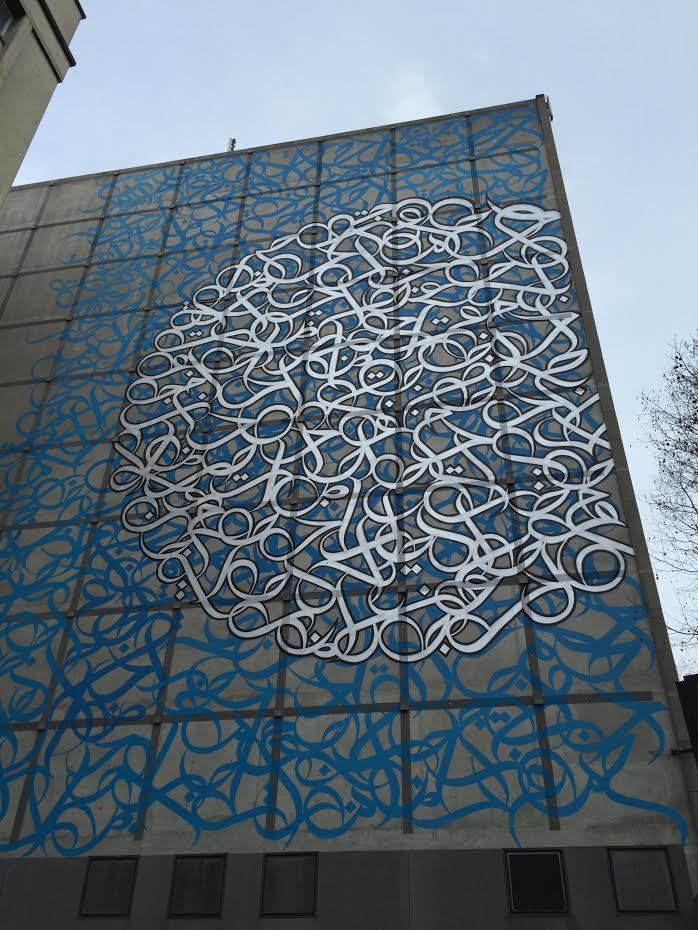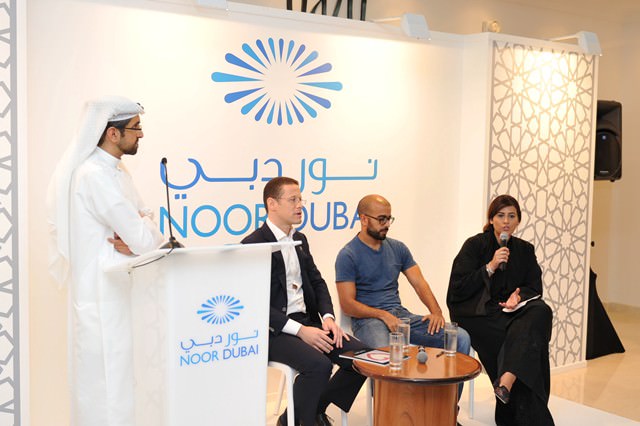
Few artists of their generation have left a global mark as French-Tunisian artist eL Seed. At thirty-five years old his monumental canvases are instantly recognizable and can be seen in cities across the world. Walls in cities as varied as Montreal, Sao Paolo, Paris, Doha, New York and Sharjah have been transformed with his magic spray can into open air galleries. Much like Banksy one never knows where next eL Seed artwork will appear.
To walk through a city with eL Seed as I have done in Paris is to experience it from a different angle altogether. While people usually admire intricate designs and architecture, eL Seed is attracted by what he sees as lost walls. These barren al fresco urban canvases yearning for attention.

I had spent four years in the French capital as a student in the mid-1990s and considered myself well informed about the city that I fell in love with. I would lose myself walking in the City of Light staring at the architecture of the buildings. Admiring the pierre de taille Haussmannien buildings constructed with massive cut stone blocks from the mid 19th century. I often overlooked the modernist structures built just after World War Two when a population explosion was sweeping Europe.
Not far from the Quartier Latin, eL Seed would enthusiastically be engaged in a conversation and then suddenly as a bird of prey that has identified its next target he would stand still, go completely silent and concentrate, marking his intended destination then bulls eye: “I want to paint that wall”.
The way eL Seed spots “lost walls” reminds me of Spiderman who glances up for a millisecond before aiming his web and shooting. It’s a split second decision. You know in your gut that that is what you want. It can’t be explained to other people. Why did Spiderman choose to shoot his web on that specific wall and not another. Swinging from one tower to the next. Why does eL Seed want that wall and not another? It’s instinctive. It can’t be explained.

June 27 2012, Paris, somewhere in the Left Bank. The following conversation transpired between us:
“Sultan brother I have an idea”
“Shoot.”
“There is this concrete wall in Gabes, my home town, it’s the tallest structure, a mosque minaret. I want to paint it, it’s a message of harmony in Tunisia, of bringing together arts and religion”
“Done.”
There was nothing to it. On June 11 and 12, a mere two weeks before our encounter, riots broke out in Tunisia after a government official visited Printemps des arts, a long running art fair in Tunis showcasing work by contemporary artists. The official snapped photos of risqué artworks and shared them with Salafi patrons of a mosque he frequented and posted them on Facebook. According to ArtInfo the Salafists threw bombs, started fires, and clashed with police in the fiercest conflict Tunisia has seen since the January 2011 revolution. Many of us in the arts community were very concerned. Thus eL Seed’s project was a masterstroke. A grand modern late 20th century mosque was in need of funding to complete the minaret and eL Seed stepped in and called the project Madinati. He labored through the summer heat, fasting in Ramadan from dawn to dusk, involving members of the community, perched on a dizzying height of 30 metres above ground on a forklift armed merely with his spray can canisters. He drew:
O mankind! We created you from a single (pair) of a male and a female, and made you into nations and tribes, that ye may know each other (not that ye may despise (each other). Surat al-Hujurat 49:13
A masterstroke indeed. A verse calling for tolerance straight from the holy Quran. A symbol of unity and respect for others. Art can come in many forms and the arts community would do well to learn from the example eL Seed set in building bridges with other elements of society across the Middle East. In 2016 eL Seed would repeat his social outreach to the neglected Zarareeb community in Cairo when he undertook a massive anamorphic piece quoting a revered Coptic saint that can best be viewed from a certain vantage point.

eL Seed is very much a landscape artist. However his landscapes are not confined to canvases measuring one by one or even two by two meters. eL Seed’s work is meant to complement an urban or even suburban environment. The cracks on the walls, the uneven surface, and the changing texture are all an intricate part of the work. He does not attempt to hide them. The imperfections accentuate the artwork.

In 2013 as part of the Lost Walls project eL Seed caused controversy when he painted the historic walls of Tatouine, a Berber oasis that became world famous as a set in George Lucas 1977 hit Star Wars. The centuries old site was neglected for decades by successive Tunisian governments. There was no trace of the famous Hollywood movie, only one guard who was paid a meager amount of money and allowed eL Seed to in his words “Do whatever you want”. eL Seed drew the words “I will never be your son” in Arabic, in response to Darth Vader’s, “I am your father.” The phrase is also a swipe at the authorities that had sadly neglected this historic town.

eL Seed mural at author’s house in Dubai. Based on poem by the late Sheikh Zayed Bin Sultan حبكم وسط الحشا سادي. لو جبل ما اتحمله كله Source: Unknown.
Once again eL Seed had made a point. Tunisia was abuzz with the fact that these sites were not protected better let alone promoted. eL Seed has embodied the spectrum of an artist from one that reflects the pulse of the community to a vehicle of social change.

During his time in Dubai eL Seed took part in community projects and workshops and allowed students to participate in creating the artworks. From Rashid School For Boys to the all women Zayed University in Dubai, his enthusiasm and positive energy has influenced many students. eL Seed’s talk at Art Dubai 2014 and again in 2016 were amongst the most crowded of all such events. Screens had to be installed in the adjacent rooms to accommodate the crowds of adoring fans who queued for an hour before the talk.
eL Seed doesn’t regard himself as a Middle Eastern or European artist although these are important factors in his life. “No one thinks of Murakami as a Japanese artist, they think of him as simply an artist” el Seed would tell me.

The appeal of eL Seed’s art cuts across cultures. At an art auction in April 2014 in which proceeds went to Noor Dubai a Chinese lady kept biding for his work, pushing the prices — and thus charity proceeds — higher. She absolutely would not let go of his artwork, which she has been coveting for sometime. When the hammer finally went down declaring hers the winning bid the entire room erupted in applause and she jumped on her feet and ran up to the podium where eL Seed was standing next to the artwork and gave him a huge heartfelt hug. The lady was gleaming; the smile never parting her face even after the event was over. In my ten years in the industry I had never seen such enthusiasm for an artist. eL Seed’s charisma is the sort that rock stars would command. After all, he is largely a performance artist.
Video: Madinati — Calligraffiti on Jara Mosque, Gabes, Tunisia.
“The first stroke is the most important” eL Seed emphasises. “If I get it right the rest of the wall flows freely, if I don’t then I’m in trouble”. eL Seed has a photographic memory. I have seen him look at a wall then take piece of paper and draw a sketch of what he has in mind. Apparently this exercise is mostly for the audience who are with him so they would have an idea of approximately what will happen next. In his mind though it’s all clear as a ship’s captain in a sunny day, he navigates through the giant loops and turns, curves and coils, up and down like a roller coaster in a Six Flags amusement park. To admire eL Seed’s artwork is to go on a thrill ride, you never know what comes after the next curve. To the unseasoned eye the work may look like a giant bowl of Italian tagliatelle but a closer look unveils words of wisdom, poetry, popular idioms and holy verse.
eL Seed has transcended the local and the regional. He is truly a world class artist. And the world is his canvas.
This article was originally published in Medium on September 5, 2016. A version of this article was first published under the title The Gamechanger for the catalogue of Declaration, eL Seed’s exhibition at Tashkeel, that ran from 20 Nov — 27 Dec 2014 in Dubai. A screenshot of this article can be downloaded here.